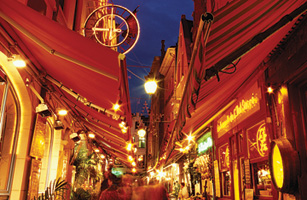
Split into two increasingly hostile language communities, Belgium has little that unites it as a country. There is one thing, however, that the people of Flanders and Wallonia still have in common: their love of food. Belgian sommelier and food writer Eric Boschman argues that the only remaining link between his country's divided citizens is how, where and what they eat. "We Belgians like to spend time at the table," he says. "Restaurants are always full, even in the smallest towns."
It helps that, unlike in most other European countries where eating out well means spending a lot of money, Belgium is filled with restaurants serving top-quality cuisine at reasonable prices. If you're in Brussels, get a table at La Canne en Ville (www.lacanneenville.be), a typical local restaurant where the steaks are always excellent, and entrées include such Belgian classics as artichoke vinaigrette. A little outside the city center, there's Le Pigeon Noir (www.lepigeonnoir.be), a quaint bistro in a former pigeon fanciers' club that serves authentic — and delicious — local dishes. Try the rabbit stewed in Kriek (cherry beer).
And the good eating isn't limited to Brussels. In the forested Ardennes, Le Grand Ryeu at Grandrieu (www.legrandryeu.be) is the place to go for a flavorful meal of foie gras with Guérande salt. Or take a trip to the Flemish coast and the Si Versailles (www.siversailles.be) in Knokke, where fish dishes such as mussels in white wine are served in traditional surroundings of dark wood and red leather, with a view of the sea.
What it comes down to, according to Boschman, "is that eating here is still a real culture." And perhaps a way for Belgians to forget their differences — at least until after dessert.
When in Belgium, try ...
Mosselen-Friet or Moules Frites
Mussels and fries
Waterzooi
Fish or chicken stewed with carrots, celery, onions and leeks
Stoemp
Potato mashed with other vegetables, often served with sausage
Filet Américain
Raw beef minced with spices, best served with fries and mayo